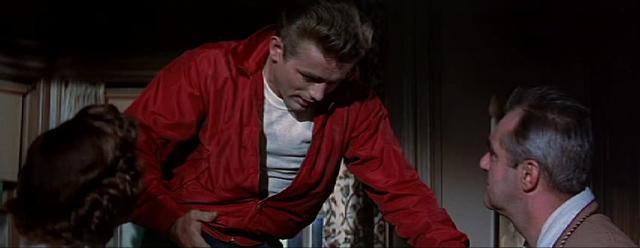Today I will talk about the way in which the relationship between parents and teenagers is portrayed in teen angst films such as
Rebel Without a Cause (1955), The Breakfast Club (1985),and
The Perks of Being a Wallflower (2012). Addressing mostly how parents affect their kids life and their view on the world, these parents range from complete devil spawns to parents that are just way too "perfect". If you were a parent, how would you treat your children? Would you be abusive and make their lives miserable? Or would you spoil them to the point where they can't find themselves? Let's take a look at what these parental attitudes do to teenagers.
Let's start with
Rebel Without a Cause. In this film, a teenager with a shady past and a extremely complacent dad, transfers to a new school and to get away from what he has done and look forward.
 |
| Jimmy arguing with his parents |
In the movie, the main character gets really offended when his masculinity is insulted, it all points to him not wanting to be like his dad; a total wimp. He has been living his life without a solid road and has no discipline when it comes to life matters. Throughout the film he does dangerous things such as drive a car off a cliff and jumping out at the last second, resulting in the death of one of his friends. All his life his dad has allowed him to get away with everything by making up lies, this time he wants to assume responsibility for what he has done and confronts his parents in a rather hostile way when he tries to explain to them he is tired of running away and having no discipline.
 |
| The Breakfast Club |
The second film,
The Breakfast Club, takes place in a school library in which five completely different teenagers are put together all day in detention for doing something bad enough for this kind of punishment. In th
past they come closer together, to the point in which they tell each other everything about themselves. As the viewer learns about their past they learn about their parents as well, and how their mistreat
e film, each character has an unique personality and sort of takes the role of a teenager stereotype; the weird girl, the dork, the jock, the rebel, and the prom queen. Mostly in the movie these individuals are literally incompatible, but as they talk more about who they are and their
ment makes them what they are. For example, the rebel has abusive parents, making him who he is; a huge bully that brings out the worst from everyone. Each character has different kinds of parents that they despise and wish they could explain to them what the "problem" is.
 |
| Charlie making a snow angel... |
In the last film,
The Perks of Being a Wallflower, there isn't much to be said about the main character's parents, except that they are too perfect and too unaware of what their son is going through. The main character, Charlie, was raped by his aunt at a young age and has gotten PTSD from that experience. He never told his parents until the day he was sent to a hospital because he attempted to kill himself. The point I'm trying to get to is that the lack of a strong and reliable father/mother figure led Charlie to be a Wallflower his entire life, and while his past was strongly devouring him from the inside out, he couldn't find anyone like him until he reached high school.








